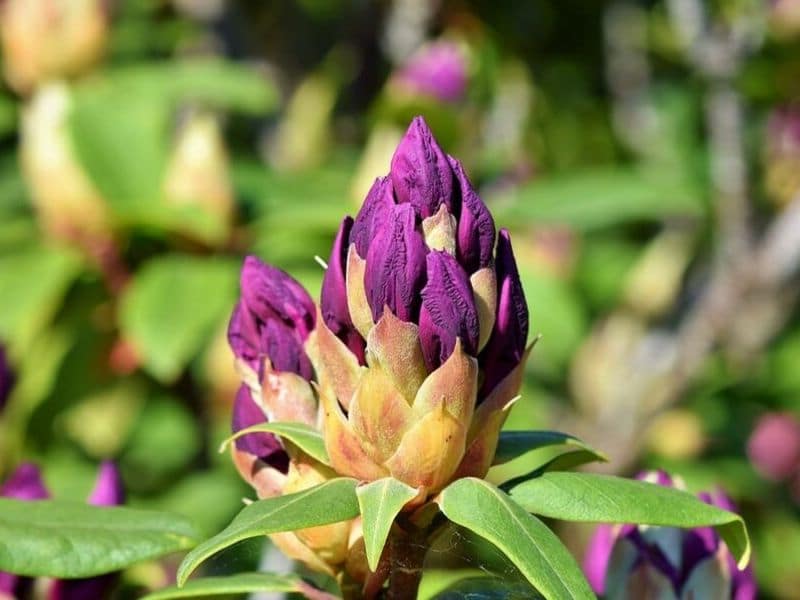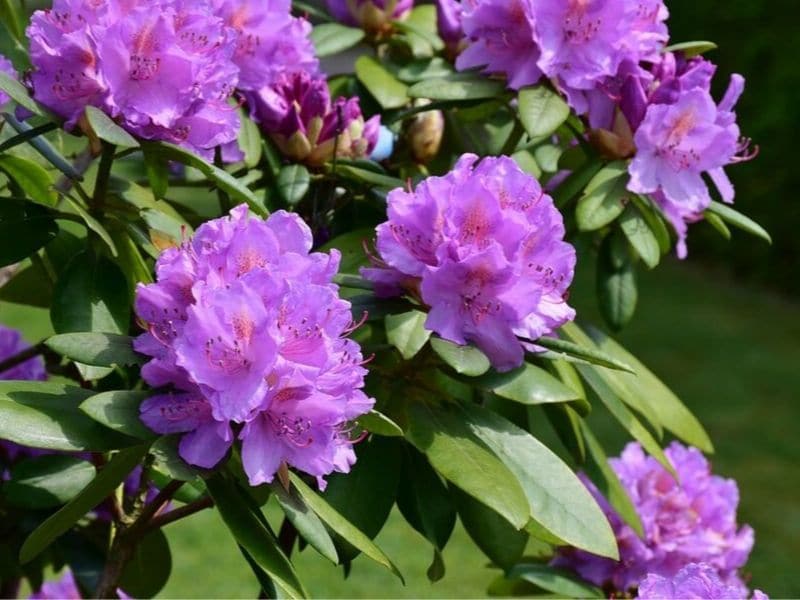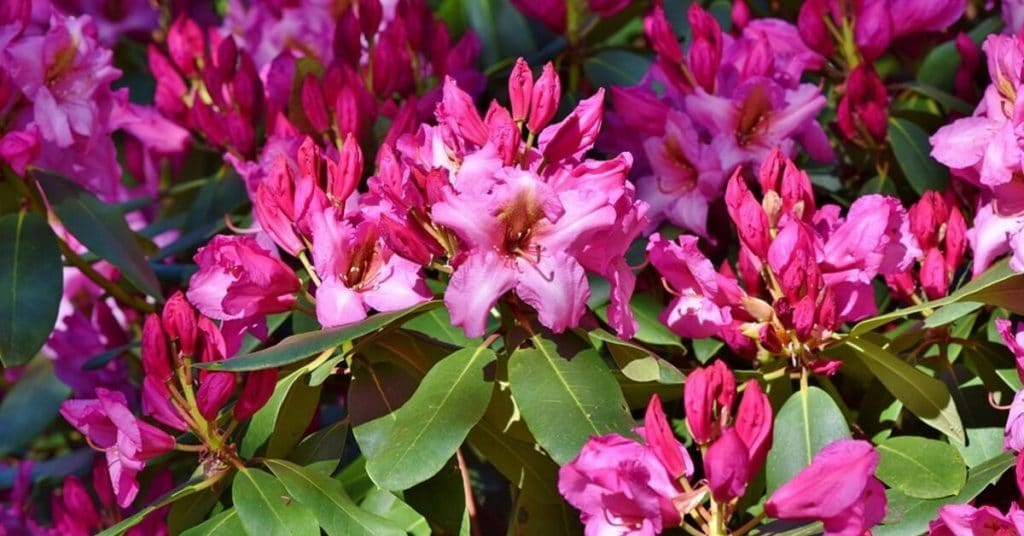Rhododendrons are famous with their long-lasting and gorgeous flowers that are enjoyed by the eye for three seasons in a row – spring, summer, and autumn.
However, very often, they are classified as difficult to grow and care. If you want to have rhododendrons in your garden but you don’t know whether you are capable of taking care of them, this guide is the perfect solution. Let’s explore!
Rhododendron Name Origin and Meaning
Rhododendron’s name comes from Greek language and means ‘the tree of roses’ (rhodo is rose in Greek and dendron means tree). Rhododendron is the national flower of Nepal and is called in different ways in local dialects (1).
History, Evolution and Use
The flower has been introduced to Europe from Asia in the mid 1700s (5).
Originally, it has been found in North and Central India and, nowadays, covers the majority of hills on 1200-1400 m height hills in the Himalayas (1).
The flower has been very popular in the area for the processed juice from its flowers which is known as rhodojuice (a.k.a. sharbat). Many parts of the plant have also been used in medicine in the past for treatment of a wide variety of diseases and medical problems. Rhododendron juice is still used in some regions for improving blood circulation and relieving hypertension (6).

For centuries, rhododendrons have been perceived as religious symbols and sacred flowers and have been used in temples for ornaments and ceremonies’ decorations.
The wood material extracted from the tree is nowadays used for making tool handles, boxes etc…
Rhododendron Flower Facts and Varieties
Rhododendron is an extremely diverse group of flowers and plants which comes in a variety of shapes, size and colour. The most common representatives which are grown in Europe, USA and Asia are formed as trees which bloom from March to November.
Scientists state that the florets of rhododendrons are some of the most varying in terms of form and structure and this makes it a more challenging flower to grow, as every type has its own preferences of light, humidity, temperature, soil and watering (2).

Still, if you follow the general advice applicable to caring for Rhododendron gene plants, you are expected to enjoy these gorgeous blossoms for the majority of the year round.
Rhododendron trees can grow to 14 m in height and 2.4 in girth. The flowers’ colour varies significantly from deep red to pink, purple, yellow and white. The trees can have up to 20 blossoms in one blooming ball.
The leaves of the tree are big and leathery and can survive moderate winter conditions without falling. They usually appear in whorls about the branch and is usually in the size range of 1-5 inches.
In general, rhododendron trees prefer climates with no extreme conditions (e.g. too hot or too cold weather). In regions where winters are severe, it is advisable to keep the rhododendron tree indoor or wrap them for protection when temperatures fall below 5°C.
Growing and Caring
As already mentioned, rhododendron trees prefer climate which is not extreme (too cold or too hot). In such regions, these trees can be planted throughout the whole year. In colder regions, it is preferable to plant the flowers in early spring or early fall.
In warmer regions, it is advised to plant rhododendrons in early fall in order to allow the root system to develop well without being exposed to severe heat (3).
This flower prefers light to medium soil. Rhododendrons also like more acid and well-drained soils with allowed access of oxygen to the roots, preventing rotten.
It is also very important to not plant the flower too deep and rather leave the top of the root ball above the soil or just below its upper layer. Planting rhododendrons too deep can lead to their death or under-performance in terms of blooming (1).
Rhododendrons can be planted in a semi-shady or no shady area but will need protection from the sun if it is exposed to very strong sunlight for a long time of the day. If you are planting them in a garden, it is recommended to put plants on a distance of 2 to 5 feet from each other (1).
Rhododendrons like fertilizers, but use them only in the spring to prevent issues from over-use and combined effect with hot weather, which can lead to burning the flower and yellowing foliage (1).
Warning: Rhododendrons are very toxic and contain grayanotoxin glycosides in all parts of the plant. Direct contact with these toxins can cause some neurologic, gastrointestinal and cardiovascular dysfunctions and issues.This is why it is advisable to wear gloves when planting or re-planting the flower (5, 7, 8).
Did you know?
Rhododendrons are also used for extraction of essential oils and for wine production! The juice of the flowers is brewed to make wine which is also believed to help solve medical problems, like diarrhea and dysentery (4, 6).
There is no specific recipe for preparing Rhododendron wine, so if you have tried to produce a flower wine before, you can try the same approach for Rhododendron too. It sounds delicious, don’t you think?
Up Next:
References
(1) Srivastava, P. (2012) Rhododendron Arboreum: An Overview. Journal of Applied Pharmaceutical Science. Vol. 2 (1), pp. 158-162.
(2) Berry, E., Geeta, R. (2019) Floral Morphology of Rhododendron and Its Relation With Pollinators. [online] Available: https://www.researchgate.net/publication/330347231_Floral_Morphology_of_Rhododendron_and_its_Relation_with_Pollinators
(3) Bharracharyya, D., Sanjappa, M. (2008) Rhododendron Habitats in India. [online] Available: https://www.researchgate.net/publication/286931541_Rhododendron_Habitats_in_India
(4) Doss, R., Hatheway, W., Hrutfiord, B. (1986) Composition of Essential Oils of Some Lipidote Rhododendrons. Phytochemistry. Vol. 25 (7), pp. 1637-1640.
(5) Furbee, B. (2009) Neurotoxic Plants. In: Clinical Neurotoxicology, pp. 523-542. Elsevier Inc.
(6) Garg, N. (2017) Technology for the Production of Agricultural Wines. In: Science and Technology of Fruit Wine Production, pp. 463-486. Elsevier Inc.
(7) Richardson, J., Little, S. (2012) Toxicology. In: The CAT. Elsevier Inc.
(8) Popescu, R., Kopp, B. (2013) The Genus Rhododendron: An Ethnopharmacological and Toxicological Review. Journal of Ethnopharmacology.
Close
Photo credit: Capri23auto&RitaE/pixabay.com







